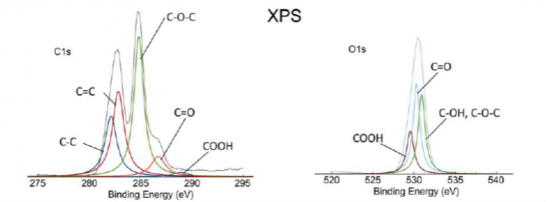北陸先端科学技術大学院大学
2014年度 成果事例
【目 的】
Our research work has been focusing on development of a novel drug delivery strategy by using nanoparticles. Recently we successfully prepared new nanoparticles that can induce a transient pore on the lipid bilayer membrane. In this study, their surface property was analyzed by X-ray photo electron spectroscopy (XPS).
【成 果】
We prepared oxidized carbon nanoparticles, which are relatively non-toxic, water dispersible, stable, and negatively charged, from oxidation of graphite. Moreover, it was found that they can induce transient pores on lipid bilayer membranes of cell-sized liposomes. All properties discovered suggest that they could be candidates of the drug carrier. In this study, X-ray photoelectron spectroscopy (XPS) was employed to characterize their surface functionalities. Figure 1 shows the result of XPS experiments, obviously indicating that there are C-O-C, C=C, C-C, C-OH and COOH functional groups could be observed in the C1s spectrum and C-O-C, C-OH, C=O and COOH functional groups could be detected in the O1s spectrum. Hence, we can confirm that the surface of oxidized carbon nanoparticles is composed of some oxygen species, corresponding to success in oxidation of graphite and thus, yielding the oxidized carbon nanoparticles.

Fig.1 XPS spectra of oxidized carbon nanoparticles; C1s (left) and O1s (right)






